Bixa orellana
Bixa orellana (Achiote) is a shrub native to a region between northern South America and Mexico.[2][3] Bixa orellana is grown in many countries worldwide.[2]
| Achiote | |
|---|---|
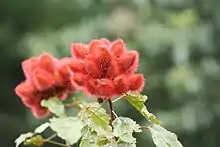 | |
| Achiote seed pods | |
| Scientific classification | |
| Kingdom: | Plantae |
| Clade: | Tracheophytes |
| Clade: | Angiosperms |
| Clade: | Eudicots |
| Clade: | Rosids |
| Order: | Malvales |
| Family: | Bixaceae |
| Genus: | Bixa |
| Species: | B. orellana |
| Binomial name | |
| Bixa orellana | |
| Synonyms[1] | |
| |
The tree is best known as the source of annatto, a natural orange-red condiment (also called achiote or bijol) obtained from the waxy arils that cover its seeds.[2][3] The ground seeds are widely used in traditional dishes in Central and South America, Mexico, and the Caribbean, such as cochinita pibil, chicken in achiote and caldo de olla. Annatto and its extracts are also used as an industrial food coloring to add yellow or orange color to many products such as butter, cheese, margarine, ice creams, meats, and condiments.[2] North, Central, and South American natives originally used the seeds to make red body paint and lipstick, as well as a spice.[3] For this reason, the Bixa orellana is sometimes called the lipstick tree.[2][3]
The species name, Bixa orellana, was given by Linnaeus after the Spanish conquistador, Francisco de Orellana, an early explorer of the Amazon River.[3][4] The name achiote derives from the Nahuatl word for the shrub, āchiotl [aːˈt͡ʃiot͡ɬ]. It may also be referred to as aploppas, or by its original Tupi name uruku, urucu or urucum ("red color"), which is also used for the body paint prepared from its seeds.[2]
Etymology and common names
The botanical genus name derives from the aboriginal Taíno word, "bixa", while the specific epithet was derived in honor of the Amazon explorer, Francisco de Orellana.[3] Colloquial names include, orellana, annatto, achiote, and many other names used regionally.[2] The nickname, "lipstick tree", derived from use of the dye as a cosmetic.[3]
Description
Bixa orellana is a perennial, tall shrub that can reach 6–10 m (20–33 ft) high.[2][3][5] It bears clusters of 5 cm (2 in) bright white or pink flowers, resembling single wild roses, that appear at the tips of the branches.[2] The fruits of the Bixa orellana are globular, ovoid capsules arranged in clusters resembling spiky looking red-brown seed pods covered in soft spines.[2] Each capsule, or pod, contains 30-45 cone shaped seeds covered in a thin waxy blood-red aril.[2] When fully mature, the pod dries, hardens, and splits open, exposing the seeds.[2]
The shrub is most well known as the source of the red-orange, annatto pigment. The pigment is derived from the pericarp (the waxy aril layer that covers the seeds) of the Bixa orellana fruit.[2][3] The red-orange annatto dye is rich in the carotenoid pigments, 80% which consists of bixin (the red pigment) and norbixin or orelline (the yellow pigment).[2][6][7]
Distribution
Although the exact origin of Bixa orellana is unknown, it is native to northern South America and the Central American tropics: "it is said to be indigenous by Seemann on the northwest coast of Mexico and Panama, by Triana in New Granada, by Meyer in Dutch Guiana, and by Piso and Claussen in Brazil”.[3] Additionally, Bixa orellana is found in substantial wild and cultivated acreages from Mexico to Ecuador, Brazil, and Bolivia.[2] Although an invasive species, it is cultivated in many world regions.[2]
During the 16th and 17th centuries, the annatto dye was distributed to Southeast Asia, Africa, the Caribbean, Hawaii and southeastern North America in tropical and subtropical regions through trading exchanges.[2][3] It became cultivated in tropical regions of Asia, such as India, Sri Lanka, and Java mainly for the dye which the seeds yield.[2]
Cultivation
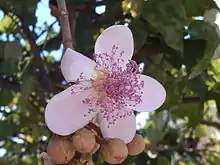
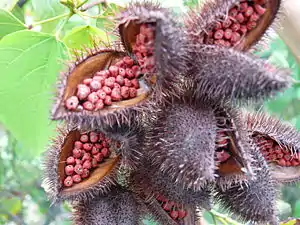
Bixa orellana grows easily in subtropical to tropical climates, in frost-free regions sheltered from cool winds.[2] It prefers year-round moisture, good drainage, and moderately fertile soil in full sun or partial shade. It can be propagated from seed and cuttings. Cutting-grown plants flower at a younger age than seedlings.[8]
The main commercial producers of B. orellana are countries in Latin America (specifically Peru, Brazil and Mexico) which constitute 60% of total world production followed by Africa (27% of total world production) and Asia (12% of total world production).[9] Production statistics are not usually available, and would not provide a reliable guide to international trade since many of the producing countries use significant quantities domestically (e.g., Brazil is a large producer and consumer, needing additional imports). Annual world production of dried annatto seed at the beginning of the 21st century was estimated at about 10,000 tons, of which 7,000 tons enter international trade. Peru is the largest exporter of annatto seed, annually about 4,000 tons; Brazil the largest producer with about 5,000 tons. Kenya exports annually about 1,500 tons annatto seed and extracts and is the second-largest exporter, after Peru. Côte d'Ivoire and Angola are also exporters.[10]
Industrial uses
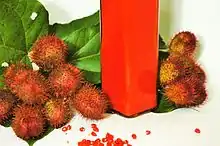
Before synthetic dyes revolutionized industry, Bixa orellana was planted commercially for its pigment, extracted from the pericarp of the seeds first by grinding the seeds and then extracting the pigment through use of enzymes, solvents or oil (corn oil or soybean oil).[2][6] Solvents include alkaline solutions like sodium hydroxide or potassium hydroxide, as well as organic solvents including hexane, acetone, chloroform and ethanol. Extractions using organic solvent yield the annatto pigment.[3][6]
The annatto pigment has global economic significance as it is one of the most widely used natural dyes to color food, cosmetics and pharmaceutical products. It is used commonly in foods because the coloring does not alter the flavor and is not toxic.[3] It is mainly used to dye ice cream, meats, dairy products (cheeses, butter and margarine) and condiments.[2][3] Cosmetic products include lipstick, hair coloring products, nail polish, soaps, lacquers and paints.[3]
Annatto oil is rich in tocotrienols, beta-carotene, essential oils, saturated and unsaturated fatty acids, flavonoids, and vitamin C.[11]
Culinary uses
Ground Bixa orellana seeds are often mixed with other seeds or spices to form a paste or powder for culinary uses in Latin American, Jamaican, Chamorro, and Filipino cuisines. The seeds are heated in oil or lard to extract their dye and flavor for use in dishes and processed foods such as cheese, butter, soup, gravy, sauces, cured meats, and other items. The seeds impart a subtle flavor and aroma and a yellow to reddish-orange color to food. In Brazil, a powder known as colorau or colorífico is made from the ground seeds combined with filler seeds like maize. This powder is similar to and sometimes replaces paprika.[12]
The Yucatecan condiment called recado rojo or "achiote paste" is made from ground Bixa orellana seeds combined with other spices and is a mainstay in Mexican and Belizean cuisines.[13] A condiment called sazón is commonly used in Spanish, Latin American, and Caribbean cuisine for meats and fish. The Spanish word sazón means "season" or "seasoning". Sazón is made with ground Bixa orellana seeds and packaged into small, disposable foil packets for easy use. Additionally, cumin, coriander seeds, salt, and garlic powder are included in these sazón condiment packets.[14] On Spanish-speaking Caribbean islands, the annatto pigment is also used to make yellow rice and is sometimes added to sofrito.[14] Additionally, in the French Caribbean, it is added to a fish or pork stew called blaff.[14]
Traditional uses
One major traditional use of the Bixa orellana plant was for body, face, and hair paint among various tribes and ancient civilizations either for decorative purposes or as omens to ward off evil spirits and illnesses.[3][15] It has been reported to be used by Brazilian native tribes, the native Taínos in Puerto Rico, the Tsáchila of Ecuador and different Amazonian tribes.[3][15][16] As a result of the Spanish Conquest, the Bixa orellana was introduced to tribes like the Aztecs, Incas and Mochicas who showed evidence of later use.[15] The Aztecs also apparently used the annatto pigment as red ink for manuscript painting in the 16th century.[3][16]
Bixa orellana is used in traditional medicine.[3][6] The tree has been used in Ayurveda, the folk medicine practices of India, where different parts of the plant are thought to be useful as therapy.[17]
The plant is valued for its stem fiber to make rope mats and for the adhesive gum.[18][19][20]
Gallery
 With fruits in Hyderabad, India
With fruits in Hyderabad, India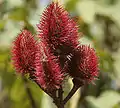 Fruit in Hyderabad, India
Fruit in Hyderabad, India_seeds.jpg.webp) Split seed pod
Split seed pod Flower closeup
Flower closeup Fruit
Fruit Bixa orellana - MHNT
Bixa orellana - MHNT
References
- Kew World Checklist of Selected Plant Families
- "Bixa orellana (annatto)". Center for Agriculture and Biosciences International (CABI). 27 September 2018. Retrieved 10 October 2018.
- Julia F Morton (1960). "Can Annatto (Bixa orellana, L.), an old source of food color, meet new needs for safe dye?". Proceedings of the Florida State Horticultural Society. 73: 301–309. Retrieved 10 October 2018.
- Levy, Luis W.; Rivadeneira, Diana M. (2000). "Annatto". In Lauro, Gabriel J.; Francis, F. Jack (eds.). Natural Food Colorants Science and Technology. IFT Basic Symposium Series. New York: Marcel Dekker. p. 115. ISBN 978-0-8247-0421-6.
- "Plants profile for Bixa orellana (lipsticktree)". Plants database, US Department of Agriculture. Retrieved 2019-04-19.
- Vilar, Daniela de Araújo; Vilar, Marina Suênia de Araujo; Moura, Túlio Flávio Accioly de Lima e; Raffin, Fernanda Nervo; Oliveira, Márcia Rosa de; Franco, Camilo Flamarion de Oliveira; de Athayde-Filho, Petrônio Filgueiras; Diniz, Margareth de Fátima Formiga Melo; Barbosa-Filho, José Maria (2014). "Traditional Uses, Chemical Constituents, and Biological Activities of Bixa orellana L.: A Review". The Scientific World Journal. 2014: 857292. doi:10.1155/2014/857292. ISSN 2356-6140. PMC 4094728. PMID 25050404.
- Ul-Islam, S; Rather, LJ; Mohammad, F (2015). "Phytochemistry, biological activities and potential of annatto in natural colorant production for industrial applications – A review". Journal of Advanced Research. 7 (3): 499–514. doi:10.1016/j.jare.2015.11.002. PMC 4856788. PMID 27222755.
- Lord, Tony (2003) Flora : The Gardener's Bible : More than 20,000 garden plants from around the world. London: Cassell. ISBN 0-304-36435-5
- Raddatz-Mota, Denise; Pérez-Flores, Laura J.; Carrari, Fernando; et al. (May 2017). "Achiote (Bixa orellana L.): a natural source of pigment and vitamin E". Journal of Food Science and Technology. 54 (6): 1729–1741. doi:10.1007/s13197-017-2579-7. ISSN 0022-1155. PMC 5430180. PMID 28559632.
- Jansen, P. C. M. (2005). Jansen, P. C. M.; Cardon, D. (eds.). "Bixa orellana L." PROTA 3: Dyes and tannins/Colorants et tanins. PROTA. Archived from the original on 20 November 2008. Retrieved 5 Oct 2014.
- Ângela de Almeida Meireles, Maria; Lima Cavalcante de Albuquerque, Carolina. "Processo otimizado para obtenção de óleo rico em antioxidantes de urucum" (PDF). Inova (in Portuguese). Unicamp. Retrieved 2 Jun 2015.
- "New Crops from Brazil". Purdue University. 1990. Retrieved 24 August 2011.
- "RECIPE: Recado Rojo :: LOS DOS". www.los-dos.com. Retrieved 2019-04-19.
- "Achiote: The Spice That Dyes Food Yellow". The Spruce Eats. Retrieved 2019-04-19.
- Donkin, R. A. (1974). "Bixa Orellana: "The Eternal Shrub"". Anthropos. 69 (1/2): 33–56. ISSN 0257-9774. JSTOR 40458510.
- "Colorants Used During Mexico's Early Colonial Period". Stanford University. 1997. Archived from the original on March 20, 2008. Retrieved 24 August 2011.
- Khare, C.P. (2007). Indian Medicinal Plants. New York: Springer Science+Business Media, LLC. ISBN 978-0-387-70638-2.
- Ellison, Don (1999) Cultivated Plants of the World. London: New Holland (1st ed.: Brisbane: Flora Publications International, 1995)
- Graf, Alfred Byrd (1986) Tropica: color cyclopedia of exotic plants and trees for warm-region horticulture--in cool climate the summer garden or sheltered indoors; 3rd ed. East Rutherford, N.J.: Roehrs Co
- Macoboy, Stirling (1979) What Tree is That?, Sydney, Australia (1st ed.: Sydney: Ure Smith). ISBN 0-7254-0480-9
External links
 Media related to Bixa orellana at Wikimedia Commons
Media related to Bixa orellana at Wikimedia Commons
